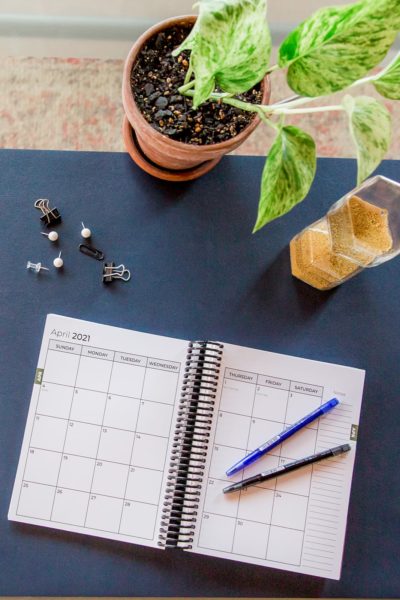We know the first step to finding daily peace of mind is an organized schedule. With so many different types of planners and ways of scheduling out there, however, it can be difficult to know the most effective way to keep track of all the events and tasks in your life. Focus on a month at a time, and you might miss out on some of the daily details. Get too bogged down in the daily nitty-gritty, though, and you may lose sight of the larger goals on your horizon. So what’s better- a monthly planner or a weekly planner?
Fortunately, there are planners that offer the best of both worlds. Using a planner that has sections for both weekly and monthly schedules can help you stay on track both daily and in the long-term — as long as you know how to use it effectively. Using a weekly planner and using a monthly planner wrapped into one can be a great way to stay organized. Let’s take a look at how you can take advantage of both views to manage your time, clear your mind, and live a more organized and fulfilling life.
Monthly Planner vs. Weekly Planner
First, what’s the difference between the monthly and weekly sections in your planner? The monthly schedule looks like a traditional calendar page, with a small block of space for every day of the month. This format allows you to keep a bird’s-eye view of what’s ahead.
The weekly schedule, meanwhile, is also a two-page spread, but it covers a single week with more space for every day and has extra space for weekly notes. This makes it perfect for capturing all the details you’ll need to know, when you need them.

Monthly Planner: Look at the Big Picture
Think of your monthly planner as your scheduling assistant. It doesn’t need to have every detail of your upcoming events, but it should have enough to keep you from double-booking yourself or failing to prepare or a big event on your horizon. If you need to schedule an appointment, for example, you want to be able to see at a glance what days are available, without having to read through notes on every upcoming event.
With that in mind, get in the habit of jotting down event times with a short label in your monthly schedule. Think “7 PM Book Club” rather than “Book club meeting on Eat Pray Love at the Corner Café, 7 PM.” You’ll keep track of the rest of the details like location and event specifics in the weekly view, so all you need to know on your monthly schedule is that you’re booked — pun intended! — at 7 PM on the 15th.
Consider carefully what recurring events to note in your monthly planner in order to keep it from becoming unnecessarily crowded. If you pick up the kids from school at 3 PM daily, for example, you don’t need to write that in every day. A weekly dinner, however, would likely benefit from a brief note, just to make sure you don’t forget it when scheduling other things.
When it comes to important events — whether that’s a big work deadline, your daughter’s birthday party, or anything else you want to have in mind more than a week in advance — you may want to highlight it just to make sure it stays on your radar whenever you check your planner. As with most things in life, though, moderation is key. The more things you have highlighted on your schedule, the less any of them will stand out!
Less is More
This brings us to the main principle to have in mind when it comes to maintaining your monthly schedule: Less is more. The more crowded your monthly calendar becomes with details, the less useful it will be to you when you’re trying to quickly find an open slot for a lunch date or doctor’s appointment. Keep the monthly view to the bare-bones essentials, and leave the meatier info to the weekly pages.
Weekly Planner: Dive into the Details
If the monthly view is your scheduling assistant, the weekly view is your personal secretary, armed with all the details so you don’t have to remember them. The weekly schedule should provide you with all the info you need for a given event, while still being easy to read and organized.
Keep track of the time, the event, and whatever else you need to know: the location, who you’re meeting, what to bring, and anything else relevant. If you ever find yourself saying, “Don’t forget ____!” write it down here, so you can free up mental energy from constantly trying to keep it in mind.
We know events don’t always come up in chronological order, so leave yourself some margin. As a general rule, write down morning events in the top half of a day’s space, and put the afternoon and evening events in the bottom lines. This will give you an approximate view of when you have free time throughout the week, so you can plan for errands and other chores.
For tasks that aren’t scheduled events — such as mailing a card, or dropping off dry cleaning — jot it down on the day you need to do it, or in the Notes section for more general weekly reminders, and cross off items as they’re completed.
You can also use the Notes section for weekly goals. Not only will writing out your intentions help solidify them in your mind, but you’ll also be reminded of them every time you check your schedule — which, if you’re using it correctly, will likely be a lot!
When to Use?
The final question is when you should use each section. Because the weekly section is made for details, we recommend writing events down here when you first schedule them. This way, you can be sure all the info is correct from the get-go. Then, copy only the essentials into the monthly view.
Make a habit of reviewing your schedule at the beginning of every month for any upcoming events, and look over it at the start of every week to check when you’ll have time for household chores and other tasks. Pencil in a general outline for your week so you won’t have to spend time and energy at the start of every day wondering what you need to get done, while still leaving room for life and the unexpected to happen.
Ready to get started? Check out our Thrive 2021 Ultimate Weekly Planner with its combo of weekly and monthly schedules to start putting your year in order. Your priorities — and peace of mind! — are waiting for you.


